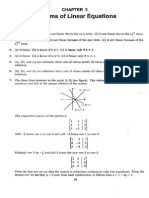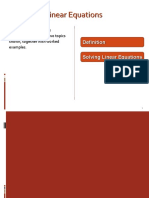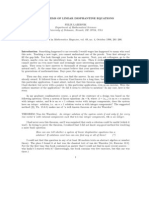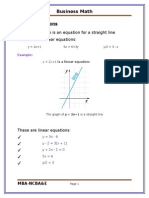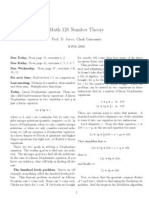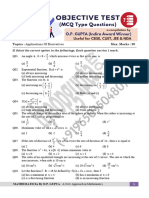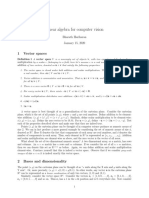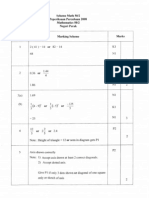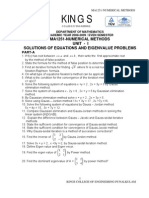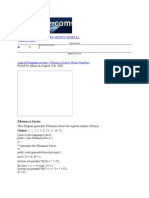LI2025
LI2025
Uploaded by
Worse To Worst SatittamajitraCopyright:
Available Formats
LI2025
LI2025
Uploaded by
Worse To Worst SatittamajitraOriginal Description:
Copyright
Available Formats
Share this document
Did you find this document useful?
Is this content inappropriate?
Copyright:
Available Formats
LI2025
LI2025
Uploaded by
Worse To Worst SatittamajitraCopyright:
Available Formats
10
Chapter One. Linear Systems
is an equation with only one variable. From that we get the first number in the
solution and then we get the rest with back-substitution. This method takes longer
than Gausss Method, since it involves more arithmetic operations, and is also
more likely to lead to errors. To illustrate how it can lead to wrong conclusions,
we will use the system
x + 3y = 1
2x + y = 3
2x + 2y = 0
from Example 1.13.
(a) Solve the first equation for x and substitute that expression into the second
equation. Find the resulting y.
(b) Again solve the first equation for x, but this time substitute that expression
into the third equation. Find this y.
What extra step must a user of this method take to avoid erroneously concluding a
system has a solution?
X 1.20 For which values of k are there no solutions, many solutions, or a unique
solution to this system?
x y=1
3x 3y = k
X 1.21 This system is not linear in that it says sin instead of
2 sin cos + 3 tan = 3
4 sin + 2 cos 2 tan = 10
6 sin 3 cos + tan = 9
and yet we can apply Gausss Method. Do so. Does the system have a solution?
X 1.22 What conditions must the constants, the bs, satisfy so that each of these
systems has a solution? Hint. Apply Gausss Method and see what happens to the
right side.
(a) x 3y = b1
(b) x1 + 2x2 + 3x3 = b1
3x + y = b2
2x1 + 5x2 + 3x3 = b2
x1
+ 8x3 = b3
x + 7y = b3
2x + 4y = b4
1.23 True or false: a system with more unknowns than equations has at least one
solution. (As always, to say true you must prove it, while to say false you must
produce a counterexample.)
1.24 Must any Chemistry problem like the one that starts this subsection a balance
the reaction problem have infinitely many solutions?
X 1.25 Find the coefficients a, b, and c so that the graph of f(x) = ax2 + bx + c passes
through the points (1, 2), (1, 6), and (2, 3).
1.26 After Theorem 1.5 we note that multiplying a row by 0 is not allowed because
that could change a solution set. Give an example of a system with solution set S0
where after multiplying a row by 0 the new system has a solution set S1 and S0 is
a proper subset of S1 . Give an example where S0 = S1 .
Section I. Solving Linear Systems
11
1.27 Gausss Method works by combining the equations in a system to make new
equations.
(a) Can we derive the equation 3x 2y = 5 by a sequence of Gaussian reduction
steps from the equations in this system?
x+y=1
4x y = 6
(b) Can we derive the equation 5x 3y = 2 with a sequence of Gaussian reduction
steps from the equations in this system?
2x + 2y = 5
3x + y = 4
(c) Can we derive 6x 9y + 5z = 2 by a sequence of Gaussian reduction steps
from the equations in the system?
2x + y z = 4
6x 3y + z = 5
1.28 Prove that, where a, b, . . . , e are real numbers and a 6= 0, if
ax + by = c
has the same solution set as
ax + dy = e
then they are the same equation. What if a = 0?
X 1.29 Show that if ad bc 6= 0 then
ax + by = j
cx + dy = k
has a unique solution.
X 1.30 In the system
ax + by = c
dx + ey = f
each of the equations describes a line in the xy-plane. By geometrical reasoning,
show that there are three possibilities: there is a unique solution, there is no
solution, and there are infinitely many solutions.
1.31 Finish the proof of Theorem 1.5.
1.32 Is there a two-unknowns linear system whose solution set is all of R2 ?
X 1.33 Are any of the operations used in Gausss Method redundant? That is, can we
make any of the operations from a combination of the others?
1.34 Prove that each operation of Gausss Method is reversible. That is, show that
if two systems are related by a row operation S1 S2 then there is a row operation
to go back S2 S1 .
? 1.35 [Anton] A box holding pennies, nickels and dimes contains thirteen coins with
a total value of 83 cents. How many coins of each type are in the box? (These are
US coins; a penny is 1 cent, a nickel is 5 cents, and a dime is 10 cents.)
? 1.36 [Con. Prob. 1955] Four positive integers are given. Select any three of the
integers, find their arithmetic average, and add this result to the fourth integer.
Thus the numbers 29, 23, 21, and 17 are obtained. One of the original integers
is:
12
Chapter One. Linear Systems
(a) 19
(b) 21
(c) 23
(d) 29
(e) 17
? X 1.37 [Am. Math. Mon., Jan. 1935] Laugh at this: AHAHA + TEHE = TEHAW. It
resulted from substituting a code letter for each digit of a simple example in
addition, and it is required to identify the letters and prove the solution unique.
? 1.38 [Wohascum no. 2] The Wohascum County Board of Commissioners, which has
20 members, recently had to elect a President. There were three candidates (A, B,
and C); on each ballot the three candidates were to be listed in order of preference,
with no abstentions. It was found that 11 members, a majority, preferred A over
B (thus the other 9 preferred B over A). Similarly, it was found that 12 members
preferred C over A. Given these results, it was suggested that B should withdraw,
to enable a runoff election between A and C. However, B protested, and it was
then found that 14 members preferred B over C! The Board has not yet recovered
from the resulting confusion. Given that every possible order of A, B, C appeared
on at least one ballot, how many members voted for B as their first choice?
? 1.39 [Am. Math. Mon., Jan. 1963] This system of n linear equations with n unknowns, said the Great Mathematician, has a curious property.
Good heavens! said the Poor Nut, What is it?
Note, said the Great Mathematician, that the constants are in arithmetic
progression.
Its all so clear when you explain it! said the Poor Nut. Do you mean like
6x + 9y = 12 and 15x + 18y = 21?
Quite so, said the Great Mathematician, pulling out his bassoon. Indeed,
the system has a unique solution. Can you find it?
Good heavens! cried the Poor Nut, I am baffled.
Are you?
I.2
Describing the Solution Set
A linear system with a unique solution has a solution set with one element. A
linear system with no solution has a solution set that is empty. In these cases
the solution set is easy to describe. Solution sets are a challenge to describe only
when they contain many elements.
2.1 Example This system has many solutions because in echelon form
2x
+z=3
xyz=1
3x y
=4
2x
(1/2)1 +2
(3/2)1 +3
2x
2 +3
+
z=
3
y (3/2)z = 1/2
y (3/2)z = 1/2
+
z=
3
y (3/2)z = 1/2
0=
0
Section I. Solving Linear Systems
13
not all of the variables are leading variables. Theorem 1.5 shows that an (x, y, z)
satisfies the first system if and only if it satisfies the third. So we can describe
the solution set {(x, y, z) | 2x + z = 3 and x y z = 1 and 3x y = 4 } in this
way.
{ (x, y, z) | 2x + z = 3 and y 3z/2 = 1/2}
()
This description is better because it has two equations instead of three but it is
not optimal because it still has some hard to understand interactions among the
variables.
To improve it, use the variable that does not lead any equation, z, to describe
the variables that do lead, x and y. The second equation gives y = (1/2)(3/2)z
and the first equation gives x = (3/2)(1/2)z. Thus we can describe the solution
set in this way.
{(x, y, z) = ((3/2) (1/2)z, (1/2) (3/2)z, z) | z R }
()
Compared with (), the advantage of () is that z can be any real number.
This makes the job of deciding which tuples are in the solution set much easier.
For instance, taking z = 2 shows that (1/2, 5/2, 2) is a solution.
2.2 Definition In an echelon form linear system the variables that are not leading
are free.
2.3 Example Reduction of a linear system can end with more than one variable
free. Gausss Method on this system
x+ y+ z w= 1
y z + w = 1
3x
+ 6z 6w = 6
y + z w = 1
x+
31 +3
32 +3
2 +4
y+ z w= 1
y z + w = 1
3y + 3z 3w = 3
y + z w = 1
x+y+zw= 1
y z + w = 1
0= 0
0= 0
leaves x and y leading and both z and w free. To get the description that we
prefer, we work from the bottom. We first express the leading variable y in terms
of z and w, as y = 1 + z w. Moving up to the top equation, substituting for
y gives x + (1 + z w) + z w = 1 and solving for x leaves x = 2 2z + 2w.
The solution set
{(2 2z + 2w, 1 + z w, z, w) | z, w R }
has the leading variables in terms of the variables that are free.
()
14
Chapter One. Linear Systems
2.4 Example The list of leading variables may skip over some columns. After
this reduction
2x 2y
=0
z + 3w = 2
3x 3y
=0
x y + 2z + 6w = 4
2x 2y
(3/2)1 +3
(1/2)1 +4
2x 2y
22 +4
=0
z + 3w = 2
0=0
2z + 6w = 4
=0
z + 3w = 2
0=0
0=0
x and z are the leading variables, not x and y. The free variables are y and w
and so we can describe the solution set as {(y, y, 2 3w, w) | y, w R }. For
instance, (1, 1, 2, 0) satisfies the system take y = 1 and w = 0. The four-tuple
(1, 0, 5, 4) is not a solution since its first coordinate does not equal its second.
A variable that we use to describe a family of solutions is a parameter. We
say that the solution set in the prior example is parametrized with y and w.
(The terms parameter and free variable do not mean the same thing. In the
prior example y and w are free because in the echelon form system they do not
lead while they are parameters because of how we used them to describe the set
of solutions. Had we instead rewritten the second equation as w = 2/3 (1/3)z
then the free variables would still be y and w but the parameters would be y
and z.)
In the rest of this book we will solve linear systems by bringing them to
echelon form and then parametrizing with the free variables.
2.5 Example This is another system with infinitely many solutions.
x + 2y
=1
2x
+z
=2
3x + 2y + z w = 4
21 +2
31 +3
2 +3
x + 2y
=1
4y + z
=0
4y + z w = 1
x + 2y
4y + z
=1
=0
w = 1
The leading variables are x, y, and w. The variable z is free. Notice that,
although there are infinitely many solutions, the value of w doesnt vary but is
constant at 1. To parametrize, write w in terms of z with w = 1 + 0z. Then
y = (1/4)z. Substitute for y in the first equation to get x = 1 (1/2)z. The
solution set is {(1 (1/2)z, (1/4)z, z, 1) | z R }.
Parametrizing solution sets shows that systems with free variables have
Section I. Solving Linear Systems
15
infinitely many solutions. For instance, above z takes on all of infinitely many
real number values, each associated with a different solution.
We finish this subsection by developing a streamlined notation for linear
systems and their solution sets.
2.6 Definition An mn matrix is a rectangular array of numbers with m rows
and n columns. Each number in the matrix is an entry.
We usually denote a matrix with an upper case roman letters. For instance,
!
1 2.2 5
A=
3 4 7
has 2 rows and 3 columns and so is a 23 matrix. Read that aloud as two-bythree; the number of rows is always given first. (The matrix has parentheses
on either side so that when two matrices are adjacent we can tell where one
ends and the other begins.) We name matrix entries with the corresponding
lower-case letter so that a2,1 = 3 is the entry in the second row and first column
of the above array. Note that the order of the subscripts matters: a1,2 6= a2,1
since a1,2 = 2.2. We denote the set of all nm matrices by Mnm .
We use matrices to do Gausss Method in essentially the same way that we
did it for systems of equations: where a rows leading entry. is its first nonzero
entry (if it has one), we perform row operations to arrive at matrix echelon
form,where the leading entry in lower rows are to the right of those in the rows
above. We switch to this notation because it lightens the clerical load of Gausss
Method the copying of variables and the writing of +s and =s.
2.7 Example We can abbreviate this linear system
x + 2y
=4
y z=0
x
+ 2z = 4
with this matrix.
1 2
0 1
1 0
0
1
2
0
4
The vertical bar reminds a reader of the difference between the coefficients on
the systems left hand side and the constants on the right. With a bar, this is
an augmented matrix.
1 2 0 4
1 2
0 4
1 2 0 4
1 +3
22 +3
0 1 1 0
0 1 1 0
0 1 1 0
1 0 2 4
0 2 2 0
0 0 0 0
You might also like
- (Solution Manual) Contemporary Linear Algebra by Howard Anton, Robert C. BusbyDocument259 pages(Solution Manual) Contemporary Linear Algebra by Howard Anton, Robert C. BusbyLijun_Sun_326879% (14)
- (Solution Manual) Contemporary Linear Algebra by Howard Anton, Robert C. BusbyDocument259 pages(Solution Manual) Contemporary Linear Algebra by Howard Anton, Robert C. Busbystacy100% (4)
- The Cipher of Genesis PDFDocument20 pagesThe Cipher of Genesis PDFjhnmayor100% (1)
- Jungle Run: (Input)Document7 pagesJungle Run: (Input)Santosh Kumar DesaiNo ratings yet
- Lesson Plan in EnglishDocument20 pagesLesson Plan in EnglishMary Gonzales85% (27)
- Chapter 5Document84 pagesChapter 5Singh KaranNo ratings yet
- C05Document96 pagesC05tri00No ratings yet
- L 1Document10 pagesL 1Paul Arne ØstværNo ratings yet
- M290 Lecture1hDocument16 pagesM290 Lecture1hghada MohamedNo ratings yet
- Hefferon LinsystemsDocument28 pagesHefferon Linsystemsapi-261282952No ratings yet
- Lecture NotesDocument108 pagesLecture NotesjohnNo ratings yet
- 1A - Systems of Linear EquationsDocument6 pages1A - Systems of Linear EquationsNIDHINo ratings yet
- Types of SolutionsDocument6 pagesTypes of SolutionsabdullahshafiqxNo ratings yet
- Antonchap1 LinsystemsDocument23 pagesAntonchap1 Linsystemsapi-2612829520% (1)
- Kuttler LinearAlgebra AFirstCourse 2021A (020 040)Document21 pagesKuttler LinearAlgebra AFirstCourse 2021A (020 040)Fernanda Ortega LopezNo ratings yet
- Lin 3037Document8 pagesLin 3037Worse To Worst SatittamajitraNo ratings yet
- Assignment 4 Answers Math 130 Linear AlgebraDocument3 pagesAssignment 4 Answers Math 130 Linear AlgebraCody SageNo ratings yet
- 1system of Linear EquationsDocument64 pages1system of Linear EquationsJoelar OndaNo ratings yet
- Basic Law in MathematicsDocument7 pagesBasic Law in MathematicsRahmayani AshariNo ratings yet
- Linear Equation Dinesh KumarDocument20 pagesLinear Equation Dinesh KumarVibhu GoelNo ratings yet
- W1-1 Linear SystemsDocument26 pagesW1-1 Linear SystemsEmanuel JheadNo ratings yet
- System of Linear EquationsDocument75 pagesSystem of Linear Equationsnoli_ediNo ratings yet
- Notes03 - Linear EquationsDocument5 pagesNotes03 - Linear EquationsjessNo ratings yet
- Pre Calculus PrimerDocument17 pagesPre Calculus PrimeracsimsNo ratings yet
- HeeDocument7 pagesHeeWorse To Worst SatittamajitraNo ratings yet
- 1 Determinants and The Solvability of Linear SystemsDocument5 pages1 Determinants and The Solvability of Linear Systemsgauravtigga10No ratings yet
- AlgebraDocument73 pagesAlgebraVictor Alarcón CalderónNo ratings yet
- Systems of Linear Equations and MatricesDocument49 pagesSystems of Linear Equations and Matricesgosaye desalegnNo ratings yet
- Solving Simultaneous Linear EquationsDocument8 pagesSolving Simultaneous Linear EquationsEbookcrazeNo ratings yet
- PMA1014 - Linear Algebra Academic Year 2009/2010 Thomas Huettemann and Ivan TodorovDocument40 pagesPMA1014 - Linear Algebra Academic Year 2009/2010 Thomas Huettemann and Ivan TodorovTom DavisNo ratings yet
- Ch 1.1 Slides 210 SJDocument24 pagesCh 1.1 Slides 210 SJsvenka12No ratings yet
- Linear Algebra-1Document56 pagesLinear Algebra-1EDISON OCHIENGNo ratings yet
- week 1 worksheet answersDocument2 pagesweek 1 worksheet answersayushdash78No ratings yet
- Systems of Linear EccuationsDocument14 pagesSystems of Linear EccuationsRaulNo ratings yet
- Solving Systems of Linear EquationsDocument4 pagesSolving Systems of Linear EquationssamsonNo ratings yet
- Linear Algebra by Prof. R. Vittal RaoDocument5 pagesLinear Algebra by Prof. R. Vittal RaoDevraj MandalNo ratings yet
- Financial Mathematics 101 - Week 1: Lecture 2: 1 Types of LinesDocument6 pagesFinancial Mathematics 101 - Week 1: Lecture 2: 1 Types of LinesKristel AndreaNo ratings yet
- 8 2 Solv Simul Linr Eqn Inv MTRX MTHDDocument9 pages8 2 Solv Simul Linr Eqn Inv MTRX MTHDEbookcrazeNo ratings yet
- Lecture 18 Gaussian Elimination Part 3 (Infinite Solns)Document7 pagesLecture 18 Gaussian Elimination Part 3 (Infinite Solns)ffskdjfdkfjjkNo ratings yet
- Topic 5-Systems of Linear EquationsDocument46 pagesTopic 5-Systems of Linear EquationsNqobile PhokaneNo ratings yet
- Ch1 Numerical Methods Lecture NotesDocument10 pagesCh1 Numerical Methods Lecture NotesAbdiqani Mohamed AdanNo ratings yet
- 2024-02-20 MA110 Slides CompilationDocument62 pages2024-02-20 MA110 Slides CompilationmayankspareNo ratings yet
- On Systems of Linear Diophantine Equations PDFDocument6 pagesOn Systems of Linear Diophantine Equations PDFhumejiasNo ratings yet
- Linear Algebra NotesDocument39 pagesLinear Algebra NotestglakasNo ratings yet
- A New Iterative Refinement of The Solution of Ill-Conditioned Linear System of EquationsDocument10 pagesA New Iterative Refinement of The Solution of Ill-Conditioned Linear System of Equationsscribd8885708No ratings yet
- Linear Algebra Lecture Notes Ch2Document10 pagesLinear Algebra Lecture Notes Ch2Abdiqani Mohamed AdanNo ratings yet
- Linear Algebra Lecture Notes Ch3Document10 pagesLinear Algebra Lecture Notes Ch3Abdiqani Mohamed AdanNo ratings yet
- Chapter One LADocument10 pagesChapter One LAAbdiqani Mohamed AdanNo ratings yet
- Linear Algebra Lecture Notes ch1Document10 pagesLinear Algebra Lecture Notes ch1Abdiqani Mohamed AdanNo ratings yet
- Module 2 - MathDocument16 pagesModule 2 - MathreymartlaguneroNo ratings yet
- Ch1 Numerical Methods Lecture NotesDocument10 pagesCh1 Numerical Methods Lecture NotesAbdiqani Mohamed AdanNo ratings yet
- Chapter Two Algebra - 122247Document14 pagesChapter Two Algebra - 122247GetnetNo ratings yet
- Linear EquationsDocument12 pagesLinear EquationsAli ImranNo ratings yet
- MA1513 Chapter 1 Lecture NoteDocument34 pagesMA1513 Chapter 1 Lecture NoteJustin NgNo ratings yet
- PC Solve Linear SystemsDocument15 pagesPC Solve Linear SystemsHector R.100% (1)
- Systems of EquationsDocument10 pagesSystems of EquationsErdemtugs ErdenetogtokhNo ratings yet
- Number Theory DiofDocument3 pagesNumber Theory DiofΘανάσης ΔρούγαςNo ratings yet
- ALGEBRA SIMPLIFIED EQUATIONS WORKBOOK WITH ANSWERS: Linear Equations, Quadratic Equations, Systems of EquationsFrom EverandALGEBRA SIMPLIFIED EQUATIONS WORKBOOK WITH ANSWERS: Linear Equations, Quadratic Equations, Systems of EquationsNo ratings yet
- Mathematics 1St First Order Linear Differential Equations 2Nd Second Order Linear Differential Equations Laplace Fourier Bessel MathematicsFrom EverandMathematics 1St First Order Linear Differential Equations 2Nd Second Order Linear Differential Equations Laplace Fourier Bessel MathematicsNo ratings yet
- A Brief Introduction to MATLAB: Taken From the Book "MATLAB for Beginners: A Gentle Approach"From EverandA Brief Introduction to MATLAB: Taken From the Book "MATLAB for Beginners: A Gentle Approach"Rating: 2.5 out of 5 stars2.5/5 (2)
- Factoring and Algebra - A Selection of Classic Mathematical Articles Containing Examples and Exercises on the Subject of Algebra (Mathematics Series)From EverandFactoring and Algebra - A Selection of Classic Mathematical Articles Containing Examples and Exercises on the Subject of Algebra (Mathematics Series)No ratings yet
- DIM-18.pdf Del1 PDFDocument7 pagesDIM-18.pdf Del1 PDFWorse To Worst SatittamajitraNo ratings yet
- Del2.pdf Del1 PDFDocument13 pagesDel2.pdf Del1 PDFWorse To Worst SatittamajitraNo ratings yet
- Del2.pdf Del1 PDFDocument13 pagesDel2.pdf Del1 PDFWorse To Worst SatittamajitraNo ratings yet
- PermDocument170 pagesPermWorse To Worst SatittamajitraNo ratings yet
- Atc4.pdf All The Things You Are - Keith Jarrett PDFDocument5 pagesAtc4.pdf All The Things You Are - Keith Jarrett PDFWorse To Worst SatittamajitraNo ratings yet
- Perm - PDF PQ - With - Id PDFDocument173 pagesPerm - PDF PQ - With - Id PDFWorse To Worst SatittamajitraNo ratings yet
- Lew - PDF Possi PDFDocument355 pagesLew - PDF Possi PDFWorse To Worst SatittamajitraNo ratings yet
- OozeDocument161 pagesOozeWorse To Worst SatittamajitraNo ratings yet
- IterDocument167 pagesIterWorse To Worst SatittamajitraNo ratings yet
- BucketDocument164 pagesBucketWorse To Worst SatittamajitraNo ratings yet
- PQ - With - Id - PDF fkj1 PDFDocument17 pagesPQ - With - Id - PDF fkj1 PDFWorse To Worst SatittamajitraNo ratings yet
- PQ - With - Id - PDF Asdafg PDFDocument5 pagesPQ - With - Id - PDF Asdafg PDFWorse To Worst SatittamajitraNo ratings yet
- PQ - With - Id - Copy - PDF Binder1 PDFDocument13 pagesPQ - With - Id - Copy - PDF Binder1 PDFWorse To Worst SatittamajitraNo ratings yet
- HeeDocument7 pagesHeeWorse To Worst SatittamajitraNo ratings yet
- Part I (10 Points) : True (T) or False (F) : 1/-1 Point For Each Correct/incorrect AnswerDocument2 pagesPart I (10 Points) : True (T) or False (F) : 1/-1 Point For Each Correct/incorrect AnswerWorse To Worst SatittamajitraNo ratings yet
- PQ - With - Id - PDF Bad PDFDocument8 pagesPQ - With - Id - PDF Bad PDFWorse To Worst SatittamajitraNo ratings yet
- Hard 2Document3 pagesHard 2Worse To Worst SatittamajitraNo ratings yet
- AsdafgDocument2 pagesAsdafgWorse To Worst SatittamajitraNo ratings yet
- RegshDocument3 pagesRegshWorse To Worst Satittamajitra0% (1)
- AhjnbDocument7 pagesAhjnbWorse To Worst SatittamajitraNo ratings yet
- II Geometry of DeterminantsDocument4 pagesII Geometry of DeterminantsWorse To Worst SatittamajitraNo ratings yet
- Aod MCQDocument3 pagesAod MCQSatvik BharadwajNo ratings yet
- Linear Algebra TutorialDocument9 pagesLinear Algebra TutorialKrishna Kishore VangalaNo ratings yet
- Algebraic Representations and FormulaeDocument1 pageAlgebraic Representations and FormulaeBenjamin FranklinNo ratings yet
- CS3452 Theory of Computaion QuestionBankDocument14 pagesCS3452 Theory of Computaion QuestionBankammukuttyNo ratings yet
- 2021 May Algebra 4Document2 pages2021 May Algebra 4paulapatrisharNo ratings yet
- Opt_Lecture2_2019 (1)Document51 pagesOpt_Lecture2_2019 (1)Eyerusalem DeguNo ratings yet
- Percubaan PMR Perak 2008 - Maths Paper 2 (Ans)Document5 pagesPercubaan PMR Perak 2008 - Maths Paper 2 (Ans)plgan100% (3)
- KCET 2019 Question Paper MathsDocument7 pagesKCET 2019 Question Paper MathsDarshan LNo ratings yet
- MAT 350 AssignmentDocument2 pagesMAT 350 AssignmentMahzebin PushpoNo ratings yet
- Statistics Essays 1. Classification & TabulationDocument20 pagesStatistics Essays 1. Classification & TabulationShruti S KumarNo ratings yet
- Numerical Methods-Ma1251Document13 pagesNumerical Methods-Ma1251naveencsmepco100% (1)
- ProgramDocument45 pagesProgramRamesh RathodNo ratings yet
- Jacaranda VCE Maths Quest 11Document36 pagesJacaranda VCE Maths Quest 11ApnaNo ratings yet
- Answers HW 81Document2 pagesAnswers HW 81masyuki1979No ratings yet
- Maths For JBT StudentsDocument117 pagesMaths For JBT StudentsVIJAY KUMAR HEER50% (2)
- Module 6: The Mathematics of Graphs: Carlos Hilado Memorial State CollegeDocument33 pagesModule 6: The Mathematics of Graphs: Carlos Hilado Memorial State CollegeCarlo Emmanuel DioquinoNo ratings yet
- Aditional Exercises Boyd PDFDocument164 pagesAditional Exercises Boyd PDFlandinluklaNo ratings yet
- Supernec: Utd Technical Reference ManualDocument23 pagesSupernec: Utd Technical Reference ManualyhbaeNo ratings yet
- CL 9 PolynomialDocument7 pagesCL 9 PolynomialTanishq AgarwalNo ratings yet
- Revision Worksheets For Final Examination (Grade 4)Document14 pagesRevision Worksheets For Final Examination (Grade 4)m.zaeem.akhtarNo ratings yet
- LE-MATH 9-Week-1Document15 pagesLE-MATH 9-Week-1may.adinNo ratings yet
- Worksheet-Section 5.2 Infinite SeriesDocument4 pagesWorksheet-Section 5.2 Infinite SeriesJaproz SainiNo ratings yet
- Numbers and Codes: Richard Earl Mathematical Institute University of OxfordDocument15 pagesNumbers and Codes: Richard Earl Mathematical Institute University of OxfordCSP EDUNo ratings yet
- Data Structure: by Prof - Manikandan QMC College, MedavakkamDocument11 pagesData Structure: by Prof - Manikandan QMC College, MedavakkamProf.ManikandanNo ratings yet
- Lesson 11 Homework 4.4Document6 pagesLesson 11 Homework 4.4afnaercytbpqtdNo ratings yet
- Marikina Polytechnic College Graduate School Exercises 3 EDUC 602 - Statistics in Education Name of Students: - and - ScoreDocument2 pagesMarikina Polytechnic College Graduate School Exercises 3 EDUC 602 - Statistics in Education Name of Students: - and - ScoreRocel Jean Sison0% (1)
- Trig Substitutions PPDocument3 pagesTrig Substitutions PPYeetisNo ratings yet

